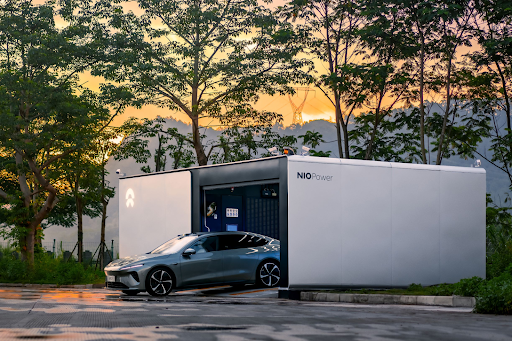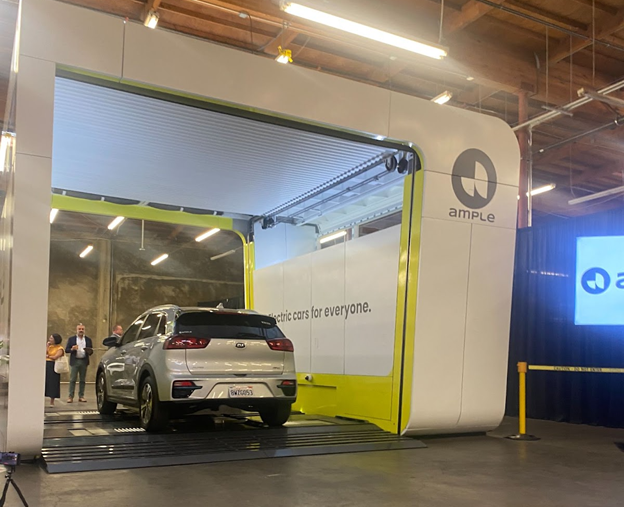- Keep Cool
- Posts
- Battery swapping: Back from the dead?
Battery swapping: Back from the dead?
Battery swapping - back from the dead?
A decade ago, there was a venture-backed battery swapping company, Better Place, that went bankrupt. While battery swapping proponents may roll their eyes at my mention of Better Place here, I promise I’m not re-introducing it to bash swapping. I bring up Better Place to explain why there is a baseline of skepticism surrounding it.
Better Place was a Palo Alto-based company that raised almost $1B in funding before going under. They integrated battery swapping into vehicles successfully. But they only sold hundreds of cars.
My post-mortem on Better Place is short: mismanagement and being a decade too early. EVs weren’t selling in 2013 the way they are in 2023. As I wrote a month ago:
...while EVs are all the rage in 2023, as recently as a decade ago, range and reliability were limiting factors that kept EV sales in places like the U.K. <5,000 vehicles per year.

A decade on, there's another company giving battery swapping a go – and at a point in time where the EV market looks very different.
Ample, based out of San Francisco, is a business I first wrote about a year ago when they were stepping back into the public eye (after a $160M Series C in 2021). The company has been building for a while; as their CEO said at the event a few weeks back, they spent the first 5-6 years of their existence in relative obscurity, solving technical challenges.
Ample recently unveiled the second generation of their battery swapping station and announced they will work with Fisker, the EV manufacturer, to integrate swappable batteries into Fisker's EVs (and to deliver vehicles by Q1 '24).
Battery swapping as a concept is relatively simple, but that doesn't mean it's easy to execute (see Better Place). Rather than charging the battery inside a vehicle, battery swapping involves taking the whole battery (or batteries) out of the vehicle and swapping in charged ones. (Imagine a vehicle that's more like an old flip phone; its battery pops in and out.)
Unlike phones, however, we're talking about moving a much larger object. EVs are notoriously heavier than their internal combustion engine counterparts, largely because of the weight of their batteries. Still, the size and weight of EV batteries don't make battery swapping impossible.
Don't take it from me, though. Take it from a vibrant market where swapping is already 'happening.'
20 million cumulative swaps!!
There should be no article or deep dive on battery swapping that mentions Better Place but doesn't include the letters' N,' 'I,' and 'O' in conjunction with one another. NIO, a Chinese EV manufacturer, has scaled battery swapping well beyond anything seen anywhere else:
All of NIO's vehicles support battery swapping, and they have amassed over 1,500 related patents. Importantly, all models also offer conventional charging options.
NIO claims their Power Swap station 3.0 can service up to 408 swaps per day (not far off from the modal traffic a normal gas station pump)
NIO has deployed 1,315 Power Swap stations in China and Europe and has completed over 20 million battery swaps cumulatively (!)
NIO's swapping stations are open only to NIO customers
60% of NIO's ~320k owners have used one of its Power Swap stations

A NIO battery swap station in China (via NIO)
NIO's sales have been boosted by general strength in the EV market and its remarkable execution. In 2022, sales were up 32.3% from 2021. The firm also plans to add an additional 1,000 battery swapping stations in China in 2023, an upwards revision from its original plan to build 400 this year.
While there are valid questions about whether NIO's customers would choose their vehicles if battery swapping were the sole charging option, it’s success demonstrates that an EV business can thrive with battery swapping as a central component of its value proposition.
Which isn't to say it will work in the U.S.
China is quite different in several ways, including the relative ease of building new infrastructure, greater consumer demand for EVs, and the average size of vehicles. But battery swapping is also taking off in places like India, especially for lightweight EVs (two and three-wheelers), where swapping a battery is less of a (literal) heavy lift.
Battery swapping… but why?
Battery swapping offers several potential benefits:
Speed: The sales pitch for swapping is, in large part, about speed. If EVs are really going to take off, they need to be able to recharge as fast as you could otherwise re-fill a tank of gas. Even the fastest commercial EV chargers only offer 30+ minute charging speeds. Battery swapping can get the process down to single-digit minutes.
Grid harmonization: It'd be easier to manage when batteries get charged if the dominant EV charging model were based on swapping. Battery swapping stations could optimize when they recharge their batteries to coincide with periods when power demand is low. Charging batteries at swapping stations can also be slow, it doesn't need to be fast.
Maintenance and end of life: Swapping makes battery maintenance way easier and lends itself well to the eventual recycling of batteries (a critical area of tech development as EV's share of the total car market climbs.)
Ample, motivated by these advantages, aims to scale battery swapping outside of China and Europe.
Their new charging station can swap a vehicle's battery array in about five minutes, and they've adopted a modular battery approach, splitting the battery pack into smaller units. This design allows for using the same batteries across multiple vehicles and enables easy capacity expansion by adding more of the same batteries, without requiring a complete battery redesign.
Here's what I wrote last year:
Ample uses an adapter plate that sits where the OEM's battery pack would typically sit. It starts empty and has a tray to hold its modular batteries. The tray and the adapter plate always stay with the car; Ample's robot swaps the batteries out of the tray. A Mini Cooper might only have 6 of the small modular batteries, whereas a utility van might have 12.
The station I saw in person is big, but not massive. I’d estimate it’s the size of ~four parking spots, of which there are many across the U.S. that we could be using for something more productive.
When a customer needs their battery swapped, they pull up into the station. The platform onto which the car parks lifts the car up off the ground to expose its underbelly, after which a robotic takes out the plate that holds the batteries.
The batteries are then taken inside the swapping station and switched out for fully charged ones. Then the platform lowers, and the customer can drive off again. Here's what the station looks like:

Mediocre image quality courtesy of my iPhone
Ample has deployed a dozen of their original swapping stations in San Francisco. Now, they want to take their v2 station and scale it, starting again in San Francisco. But as they work with more OEMs, they’ll want and need to deploy them nationwide.
Their initial focus is on fleets and service drivers (e.g., Lyft drivers), as these are a profile of car users for whom speed to charge arguably matters the most. The initial Fisker roll-out will continue to service this category.
An (steep) uphill battle
There are many challenges for Ample and battery swapping in general in the U.S. For one, America is already several miles down the road to committing to conventional EV charging. While EV charging itself today is far from sufficient, it’s a start.
With swapping, you're proposing building a parallel but distinct set of infrastructure for the coming EV revolution. Imagine if half of all cars ran on gas and filled up at gas stations while another half swapped out the car's full tank every time they needed to refill it. There would need to be entirely different stations dedicated to that.
And the build-out of conventional charging for EVs is already rife with issues. Public chargers are notoriously broken:
...public charging stations … often don't work. Parts break, information screens freeze, payment systems malfunction. Copper thieves steal the cords. Vandals damage plugs or, in one infamous instance, stuff them with ground meat.
Similarly, looking at Ample's swapping station, I see a lot of parts that could and will break. You have a mechanically raising platform. You have robotic arms exchanging heavy plates. You have the batteries themselves. And you have all software and data connections required to sync the car and the swapping port. If any of those things break, you're looking at hours, if not days, of your port being out of service.
Then there's the challenge of convincing more OEMs to work with their tech instead of just going for the conventional charging route, even in the face of all of the above listed challenges.
Then there's the station's footprint. It's not that small, certainly not as small as an EV charger. You can’t have as many ports as chargers in any one location. On average users may get in and out more quickly, but with a 5 minute swap time, if there's a long line of cars waiting to swap, the total time for a driver at the back of the line might amount to the same as for conventional charging.
Then there's the question of what happens when battery chemistries progress. What happens to the thousands of swappable batteries? I guess you try to use them to the end of their useful life and recycle and upgrade them. Ample has a technology that will allow them to run different chemistries in the same car, but there’s still a potential stranded asset problem.
Finally, what happens if conventional charging gets really fast? There are already companies claiming sub 5 minute EV charging with new technology. There’s no public data or demos to substantiate their claims yet… but it could be coming. That will still come with huge system costs (grid upgrade requirements, greater power demand), but customers might prefer it.
The net-net
None of the previous section was me trying to be a negative nelly. I’m genuinely impressed that the good folks at Ample would take this on in the face of all the challenges I mused about and battery swapping’s checkered history in the U.S.
Frankly, I’m floored by it. And I think it’s great. It’d be dumb of me to sit here and try to pontificate about whether I think this will work or not. But I am very glad Ample is trying, because, heck, ten years ago, there were as many seemingly insurmountable questions about EVs in general.
Maybe in the 2030s, we’ll say, “Thank heavens they kept at it because we sure are thankful that battery swapping exists in the U.S. now.”
Maybe we’ll say, “Thank god 10% of all EVs use battery swapping, otherwise peak load on the grid would be even harder to manage, and we’d be wasting even more daytime solar power.”
Maybe I’ll say, “I love my Stellantis with Ample’s battery swap technology to death and never want to drive an internal combustion engine with a manual transmission again.”
OK, that last one might be unlikely (stick shift lover till I die!). Concerning the others, however unlikely they may also seem, I’m cautiously optimistic.
Reply